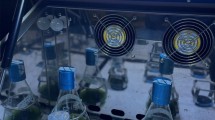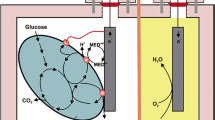Abstract
One special self-agitation reactor, which does not require a mechanical mixer or other equipment for mixing, has been introduced. Self-agitation is affected by variation in viscosity property. To obtain and research the effect of viscosity on mixing behavior in the self-agitation reactor, Fluent® was used to create numerical simulations and to visualize the fluid flow status. The results show that when the viscosity of the liquid is 1 mPa s, the entire self-agitation results in an almost completely mixed reactor. The substrate becomes difficult to agitate, and the diffusion of the substrate and the tracer become quite after every self-agitation, as the viscosity increases. Once the viscosity is higher than 25 mPa s, the substrate and tracer could not be mixed in the entire reactor, and the reactor is recognized as the combination of several completely mixed reactors between which little exchange of liquid occurs.
Graphical abstract

.





Similar content being viewed by others
References
Appels L, Baeyens J, Degrève J, Dewil R (2008) Principles and potential of the anaerobic digestion of waste-activated sludge. Prog Energ Combust 34:755–781
Eshtiaghi N, Markis F, Yap SD, Baudez J-C, Slatter P (2013) Rheological characterisation of municipal sludge: a review. Water Res 47:5493–5510
Hoffmann RA, Garcia ML, Veskivar M, Karim K, Al-Dahhan MH, Angenent LT (2008) Effect of shear on performance and microbial ecology of continuously stirred anaerobic digesters treating animal manure. Biotechnol Bioeng 100:38–48
Ji J-Y, Zheng K, Xing Y-J, Zheng P (2012) Hydraulic characteristics and their effects on working performance of compartmentalized anaerobic reactor. Bioresource Technol 116:47–52
Jiang J, Wu J, Poncin S, Li HZ (2014) Rheological characteristics of highly concentrated anaerobic digested sludge. Biochem Eng J 86:57–61
Kobayashi T, Li Y-Y (2011) Performance and characterization of a newly developed self-agitated anaerobic reactor with biological desulfurization. Bioresource Technol 102:5580–5588
Liu M (2012) Age distribution and the degree of mixing in continuous flow stirred tank reactors. Chem Eng Sci 69:382–393
Qi W-K, Guo Y-L, Xue M, Li Y-Y (2013) Hydraulic analysis of an upflow sand filter: tracer experiments, mathematical model and CFD computation. Chem Eng Sci 104:460–472
Qi W-K, Hojo T, Li Y-Y (2013) Hydraulic characteristics simulation of an innovative self-agitation anaerobic baffled reactor (SA-ABR). Bioresource Technol 136:94–101
Ratkovich N, Horn W, Helmus FP, Rosenberger S, Naessens W, Nopens I, Bentzen TR (2013) Activated sludge rheology: a critical review on data collection and modelling. Water Res 47:463–482
Wang Y, Dieude-Fauvel E, Dentel SK (2011) Physical characteristics of conditioned anaerobic digested sludge—a fractal, transient and dynamic rheological viewpoint. J Environ Sci 23:1266–1273
Wang YL, Dentel SK (2011) The effect of polymer doses and extended mixing intensity on the geometric and rheological characteristics of conditioned anaerobic digested sludge (ADS). Chem Eng J 166:850–858
Yanagida T, Fujimoto S, Minowa T (2010) Application of the severity parameter for predicting viscosity during hydrothermal processing of dewatered sewage sludge for a commercial PFBC plant. Bioresource Technol 101:2043–2045
Acknowledgments
This project was supported by the Major Science and Technology Program for Water Pollution Control and Treatment (project 2011ZX07301-003-05). The authors gratefully acknowledge the trust and support of all the members of the research team.
Author information
Authors and Affiliations
Corresponding author
Rights and permissions
About this article
Cite this article
Qi, WK., Guo, YL., Xue, M. et al. Effect of viscosity on the mixing efficiency in a self-agitation anaerobic baffled reactor. Bioprocess Biosyst Eng 38, 905–910 (2015). https://doi.org/10.1007/s00449-014-1334-y
Received:
Accepted:
Published:
Issue Date:
DOI: https://doi.org/10.1007/s00449-014-1334-y




